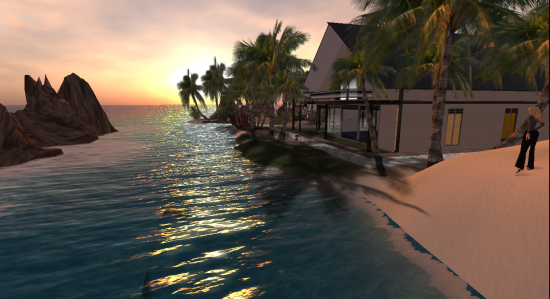There’s talk out there in the metaverse of a project to offer free, advertising-supported land in OpenSim.
I’ll provide more details as the project gets closer to reality, but there already seems to be some significant money lined up to make it possible.
So I started thinking — would I be willing to have my virtual home or office located under a giant billboard?
My initial reaction was “No!”
My ideal virtual location is on a tropical island, with white sandy beaches, and plenty of sunshine and palm trees. I live in the cold northeast, so I spend quite a bit of my time imagining myself on a warm, sunny tropical island.

But then… a tropical island can get a little lonely if you’re on it by yourself. Say there was a buzy business district in the middle. Some place where you could walk around, window shop, meet people? I would expect to see billboards in a place like that.
And I certainly wouldn’t mind having a virtual office in such a location, provided that our conversations and meetings were private and nobody could eavesdrop on our presentations if they weren’t invited.
Or, say, you’ve got your virtual island laid out with several plots on the perimeter of the island, on the beach. And the central landing area — for when people teleport in — is located on top of an inlaid floor mosaic that’s the ad itself. Totally unobtrusive, wouldn’t hurt the line of sight anywhere, yet be clearly visible to every visitor. With media-on-a-prim, that floor mosaic could even be an interactive rich media advertisement. I wouldn’t mind having a beach home on an island like that.
I wouldn’t even mind an infrequent pop-up ad, if it means that I would have a free virtual environment that’s nicer and more convenient than what I could run myself on my home computer.
What will free land mean to the metaverse?
In mid-1995, GeoCities began offering free web space to users. By the end of that year, the company was signing up thousands of new accounts a day.
The ad-supported service was wildly popular, and was the fifth most popular destination on the Web by the end of the decade and had tens of millions of personal home pages. Sure, there were also plenty of critics, but the platform offered many people their first taste of Web hosting. Over time, users moved onto other platforms like Blogger, or set up their own websites and was finally shut down last year, but it helped change the face of the Internet, to popularize it for the masses, and helped turn people into content creators, instead of passive content consumers.
A free, ad-supported service for OpenSim land could do something similar for the metaverse.
OpenSim technology continues to get better and more scalable. This year, the folks at Intel were able to run a thousand ScienceSim regions on a single server. Then they followed that up with a thousand avatars on a sim. Some OpenSim vendors are already offering load balancing capability — allowing regions to be quickly shut down when vacant and started up as they are needed. As these developments make they way into general use, it will become increasingly more economical to run virtual land — and increasingly profitable to offer ad-supported space, or space supported by merchant rentals.
As people move over the free lands, new communities will coalesce, as they did on GeoSpaces. OpenSim already offers many community-building tools, such as friends lists and groups. More tools can be added to the platform easily, such as common event areas and other gathering spots, event and classified directories, and search functions.
If the land is hypergrid-enabled (and the entrepreneur behind it assures me it will be) then residents will be able to teleport out to visit friends on other grids and visit the grids run by museums and other non-profits. They can also click on ads and be teleported to commercial grids and shopping destinations.
Biggest losers
The single biggest loser will be Second Life. At $300 a region, and given Second Life’s current infrastructure, there is no way to scale the platform up enough to offer a competing alternative. Second Life could make some dramatic changes to its technology to lower its hosting costs, or switch to using OpenSim to run some of its regions or continents, but neither of these are on the company’s roadmap.
Other private grids, like InWorldz, SpotOn3D, and 3rd Rock already offer low land prices — though not free — but provide extra protection for content creators. Will content creators be interested on staying on a closed, for-pay grid, however, if all their potential customers have moved over to the free platform?
Fortunately, InWorldz, SpotOn3D, 3rd Rock and other closed commercial grids will be able to enjoy the same technological advances as other OpenSim hosting companies, and may start to offer free land themselves if it becomes economical to do so, and only charge rent to commercial users. In fact, some grids already set aside free parcels of “homestead” land for new residents.
Other losers will include competing social virtual world platforms such as Open Wonderland, and Open Croquet, which haven’t been seeing anywhere near the adoption as OpenSim has. OpenSim has a large and growing ecosystem of service providers, hosting companies, and private and public grids. Neither Open Wonderland nor Open Croquet have that kind of adoption. In addition, the two platforms are currently not compatible with the hypergrid, though this may change. Open Wonderland is a mesh-based world, and OpenSim is expected to start supporting meshes soon after Second Life does. This means that, in theory, we might have teleports some day between worlds running on the two different platforms.
- Classic metaverse books on sale now at Amazon - May 16, 2024
- All OpenSim stats drop on grid outages - May 15, 2024
- 3rd Rock Grid residents find new homes on ZetaWorlds - May 14, 2024
